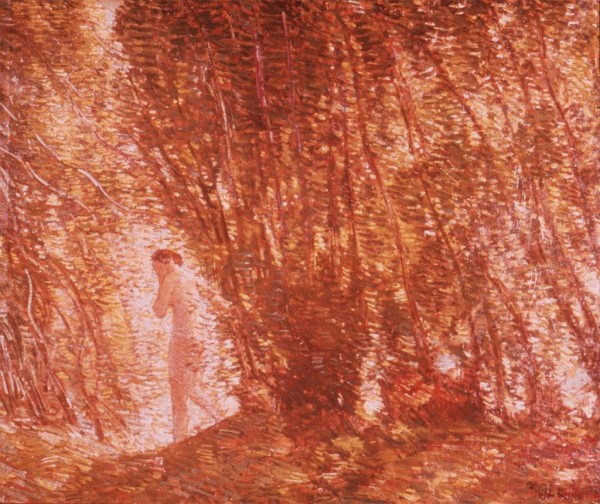Childe Hassam
Friday, 9 August 2013




From top to bottom: The West Wind, The Isle of Sholas (1904), Ravine near Branchville (c. 1910-1919), At Sunset (1900), Peach Blossoms-Villiers-le-Bel (c. 1887-89)
“Childe Hassam (1859–1935), a pioneer of American Impressionism and perhaps its most devoted, prolific, and successful practitioner, was born in Dorchester, Massachusetts (now part of Boston), into a family descended from settlers of the Massachusetts Bay Colony. Equally adept at capturing the excitement of modern cities and the charms of country retreats, Hassam (properly pronounced HASS-am) became the foremost chronicler of New York City at the turn of the century. In our day, he is perhaps best known for his depictions of flag-draped Fifth Avenue during World War I. His finest works manifest his brilliant handling of color and light and reflect his credo (stated in 1892) that “the man who will go down to posterity is the man who paints his own time and the scenes of every-day life around him.”
After establishing his reputation in Boston between 1882 and 1886, Hassam studied from 1886 to 1889 in Paris. There he was unusual among his American contemporaries in his attraction to French Impressionism, which was just beginning to find favor with American collectors. Hassam returned to the United States late in 1889 and took up lifelong residence in New York. His signature images include views of Boston, Paris, and New York, three urban centers whose places and pleasures he captured with affection and originality. Examples include Winter in Union Square and Spring Morning in the Heart of the City, both of which record lively sections of New York during the first decade of Hassam’s activity there.
While Hassam was unusual among the American Impressionists for his frequent depictions of burgeoning cities, he spent long periods in the countryside. There he found respite from urban pressures and inspiration for numerous important works of art. Hassam’s many portrayals of the old-fashioned gardens, rocky coast, and radiant sunlight of the Isles of Shoals, Maine, are among his most cherished works. Among them is the 1901 view Coast Scene, Isles of Shoals, the first canvas by the artist to enter the collection of the Metropolitan Museum. Hassam’s images of Newport, Portsmouth, Old Lyme, Gloucester, and other New England locales also exemplify the late nineteenth-century appreciation of the picturesque region redolent of early American settlement and colonial growth. In 1919, Hassam and his wife purchased a colonial-period house in East Hampton, on the south fork of Long Island, New York, and made it their summer headquarters.
Hassam created more than 2,000 oils, watercolors, pastels, and illustrations, and—after 1912—more than 400 etchings and other prints. With these works he achieved critical acclaim and commercial success, riding the great wave of enthusiasm for American Impressionism to fame and fortune.”
-H. Barbara Weinberg for The Metropolitan Museum of Art